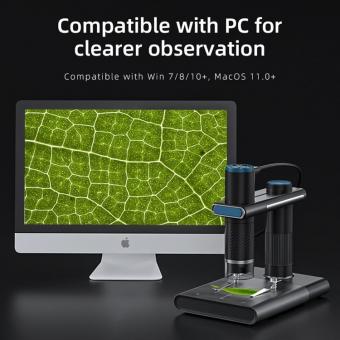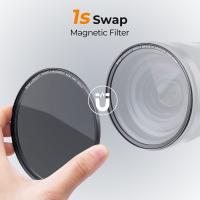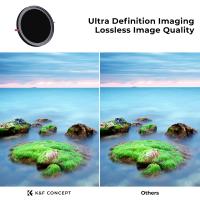Can You See Viruses With A Light Microscope ?
No, viruses cannot be seen with a light microscope. They are much smaller than the wavelength of visible light, typically ranging from 20 to 300 nanometers in size. Light microscopes have a limited resolution of around 200 nanometers, which means they cannot distinguish individual viruses. To visualize viruses, electron microscopes are used, which have much higher resolution and can magnify the samples up to millions of times.
1、 Limitations of light microscopy for visualizing viruses
Limitations of light microscopy for visualizing viruses:
Light microscopy, also known as optical microscopy, is a widely used technique for visualizing biological samples. However, when it comes to visualizing viruses, light microscopy has several limitations.
One of the main limitations is the resolution of light microscopy. The resolution of a microscope determines the smallest distance between two points that can be distinguished as separate entities. The resolution of light microscopy is limited by the wavelength of visible light, which is around 400-700 nanometers. Viruses, on the other hand, are much smaller, typically ranging from 20-300 nanometers in size. This means that most viruses are below the resolution limit of light microscopy, making it difficult to visualize them directly.
Another limitation is the contrast of light microscopy. Viruses are often transparent and lack the necessary contrast to be easily distinguished from their surroundings. Staining techniques can be used to enhance contrast, but they can also alter the structure and integrity of the virus, making it challenging to study them in their natural state.
Additionally, viruses are often present in low concentrations in biological samples, making it difficult to detect them using light microscopy. This is especially true for viruses that cause latent or chronic infections, where the viral load is low.
However, recent advancements in light microscopy techniques have allowed for some visualization of viruses. Super-resolution microscopy techniques, such as stimulated emission depletion (STED) microscopy and structured illumination microscopy (SIM), have improved the resolution of light microscopy beyond the diffraction limit, enabling the visualization of smaller structures, including some viruses.
In conclusion, while light microscopy has its limitations in visualizing viruses due to resolution, contrast, and low viral concentrations, recent advancements in super-resolution microscopy have provided some insights into the structure and behavior of certain viruses. However, electron microscopy remains the gold standard for visualizing viruses, as it offers higher resolution and contrast.

2、 Viral size and resolution of light microscopes
Viral size and resolution of light microscopes have been a topic of interest and debate among scientists for many years. Light microscopes, which use visible light to magnify and visualize objects, have certain limitations when it comes to observing viruses.
Viruses are incredibly small, typically ranging in size from 20 to 300 nanometers. This poses a challenge for light microscopes, as their resolution is limited by the wavelength of visible light, which is around 400 to 700 nanometers. This means that light microscopes cannot directly visualize viruses due to their size falling below the resolution limit.
However, advancements in microscopy techniques have allowed scientists to indirectly observe viruses using light microscopes. One such technique is immunofluorescence, where specific antibodies are used to label viral proteins, allowing them to be visualized under a microscope. This method has been instrumental in studying viral infections and understanding their mechanisms.
Additionally, recent developments in super-resolution microscopy have pushed the boundaries of what can be observed with light microscopes. Techniques such as stimulated emission depletion (STED) microscopy and structured illumination microscopy (SIM) have enabled researchers to achieve resolutions beyond the diffraction limit of light, allowing for the visualization of smaller structures, including some viruses.
Despite these advancements, it is important to note that not all viruses can be observed using light microscopes. Some viruses are simply too small or lack the necessary features to be visualized with current techniques. In such cases, electron microscopy, which has much higher resolution, is often employed.
In conclusion, while light microscopes have limitations in directly visualizing viruses due to their small size, advancements in techniques such as immunofluorescence and super-resolution microscopy have allowed for indirect observation. However, electron microscopy remains the gold standard for studying viruses at the highest resolution.

3、 Techniques enhancing virus visibility under light microscopy
Can you see viruses with a light microscope? The answer is generally no, as viruses are typically too small to be directly observed using a light microscope. Light microscopes have a limited resolution, typically around 200-300 nanometers, which is larger than most viruses. Viruses range in size from about 20 to 300 nanometers, with some exceptions on either end of the spectrum.
However, there are techniques that can enhance virus visibility under light microscopy. One such technique is immunofluorescence, where specific antibodies are used to label the viruses with fluorescent dyes. This allows for the visualization of viruses under a light microscope by detecting the emitted fluorescence. Another technique is the use of contrast agents, such as heavy metal stains, which can increase the visibility of viruses by enhancing the contrast between the virus and its surroundings.
In recent years, advancements in microscopy technology have allowed for improved visualization of viruses. Super-resolution microscopy techniques, such as stimulated emission depletion (STED) microscopy and structured illumination microscopy (SIM), have pushed the limits of resolution beyond the diffraction limit of light. These techniques can provide detailed images of viruses and their interactions with host cells, offering valuable insights into viral replication and pathogenesis.
It is important to note that while light microscopy techniques can enhance virus visibility, electron microscopy remains the gold standard for directly visualizing viruses. Electron microscopes have much higher resolution capabilities, allowing for the direct observation of viruses at the nanoscale level.
In conclusion, while light microscopes alone may not be able to directly visualize viruses, techniques such as immunofluorescence and contrast agents can enhance virus visibility. Furthermore, advancements in super-resolution microscopy have pushed the boundaries of what can be observed using light microscopy. However, electron microscopy remains the most powerful tool for directly visualizing viruses.

4、 Challenges in identifying and distinguishing viruses using light microscopy
Challenges in identifying and distinguishing viruses using light microscopy have been well-documented. While light microscopy is a powerful tool for visualizing cells and larger microorganisms, it has limitations when it comes to detecting and observing viruses.
One of the main challenges is the size of viruses. Most viruses are significantly smaller than the resolution limit of light microscopes, which is around 200-300 nanometers. This means that viruses are often too small to be directly observed using traditional light microscopy techniques.
Another challenge is the lack of contrast between viruses and their surroundings. Viruses are composed of proteins and genetic material, which have similar refractive indices to their surrounding medium. This makes it difficult to distinguish viruses from the background noise using light microscopy alone.
Furthermore, viruses often require specific staining techniques to enhance their visibility. These stains can be toxic to living cells, limiting their use in studying viruses within their natural environment.
However, recent advancements in light microscopy techniques have allowed for some progress in visualizing viruses. Super-resolution microscopy techniques, such as stimulated emission depletion (STED) microscopy and structured illumination microscopy (SIM), have improved the resolution limit of light microscopes, enabling the visualization of smaller structures, including some viruses.
Additionally, fluorescent labeling techniques have been developed to specifically label viral components, making them more visible under light microscopy. This has facilitated the study of virus-host interactions and the dynamics of viral replication within cells.
In conclusion, while light microscopy has its limitations in directly visualizing viruses, recent advancements in technology have improved our ability to detect and study viruses using light microscopy techniques. However, it is important to note that electron microscopy remains the gold standard for visualizing viruses due to its higher resolution and ability to directly observe viral structures.






























There are no comments for this blog.